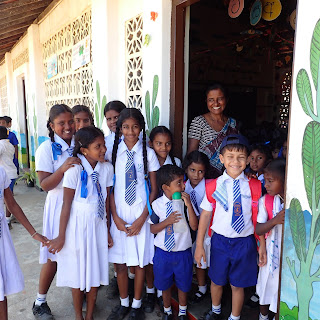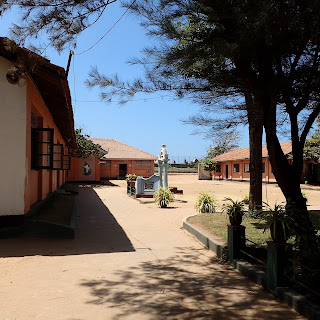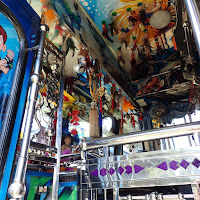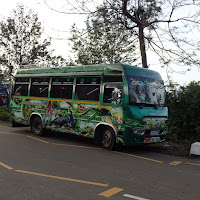 When he was young, Toby lived for a while in the same house as his aunts, in Colombo. The same house the aunts live in still. During our visits, I was very happy when his aunt Moi (Moira) showed me around, shared a few stories, and taught me how to prepare some traditional Sri Lankan foods!
When he was young, Toby lived for a while in the same house as his aunts, in Colombo. The same house the aunts live in still. During our visits, I was very happy when his aunt Moi (Moira) showed me around, shared a few stories, and taught me how to prepare some traditional Sri Lankan foods!The aunts' house is about 90 years old. The decor hasn't changed much for a long time. But it's very clean and tidy . With everything in its place. For me, that was charming. It was a glimpse into Toby's past.
 The most interesting part of the house was the little back yard and its open shed. Like many Sri Lankan back yards, this one has several plants that provide food, including bananas. On our last visit to the aunts house, Toby and I got to harvest some. Totally cool!!!
The most interesting part of the house was the little back yard and its open shed. Like many Sri Lankan back yards, this one has several plants that provide food, including bananas. On our last visit to the aunts house, Toby and I got to harvest some. Totally cool!!!The shed was also magic! It was only about 8' x 4'. But this is where the family dairy cow used to live! Until the aunts grew up. Except for every evening, when a hired man took the cow out for a good exercise walk! The shed also had lots of neat tools. A little clay stove and pot holder used to make tea and string hoppers. A coconut shredder that you could sit on. And mortar and pestle for grinding spices! Every day.

The kitchen was also really neat! There, his aunt Moi showed me how to make string hoppers, sambal, and potato curry.
Pictures
1-Me, chopping the trunk of the banana plant into small pieces for the garbage/compost truck to accept. Look at my knife action!!!
2- Toby proudly holding the bunch of bananas we harvested. Most of them were green. But enough were ripe that we got to eat some that day, and some before we flew home to Canada. Yum!!!!
3- The trunk of the banana plant is made of layers that look kinda like corrugated cardboard full of water. Pretty easy to cut.
4-Toby and his aunt Moira with a piece of dried coconut shell. In the little shed in the backyard.
5-Toby with the mortar and pestle used to grind spices each day.
6-Aunt Moira steam cooking the string hoppers. String hoppers are like little flat piles of thin rice noodles. Very tasty with dhal and other curries!
 7- The countertop coconut grinder, and a bowl of fresh coconut milk.
7- The countertop coconut grinder, and a bowl of fresh coconut milk.8- The tool to make the string hoppers. Like a playdoh press. And little piles of string hoppers on a plate.
9- The inside of the aunts' house. Like stepping back in time into a cool calm space.
10-11 Toby used to take a steam train from the Dematagoda station, near his house, to the Maradana station further from his house, then walk to school. This is the steam engine from his youth! And the Maradana station, looking almost exactly the same as back then!
12- When we arrived at the Maradana station, looking a little lost, this lady stepped right up to offer directions. So charming! Then she crossed a crazy busy 4 lanes of traffic like it was a walk in the park! We also crossed that street, using the overhead pedestrian walkway....
13- The front of the aunts house. Located on a very pleasant quiet dead end street.
































